- Matteini.org
Main menu:
IT HAPPENED TODAY...
JANUARY 6
 Here in Italy, but I think also in other countries where it is celebrated, we use to say "Epiphany, all the holidays are taken away..", but I think few people know the meaning of Epiphany. Well, it is fair to know that it is a Christian feast celebrated twelve days after Christmas. For the Western Churches, who consider it the greatest Easter of Light, that day falls on January 6, while for the Eastern Churches who follow the Julian calendar it corresponds to January 19 of the civil calendar.
Here in Italy, but I think also in other countries where it is celebrated, we use to say "Epiphany, all the holidays are taken away..", but I think few people know the meaning of Epiphany. Well, it is fair to know that it is a Christian feast celebrated twelve days after Christmas. For the Western Churches, who consider it the greatest Easter of Light, that day falls on January 6, while for the Eastern Churches who follow the Julian calendar it corresponds to January 19 of the civil calendar.
So.. HAPPY EPIPHANY

27TH JANUARY
Memory Day
Holocaust Memorial Day is an international holiday celebrated on 27 January each year as a day to commemorate the victims of the Holocaust.
It was decided to celebrate the Holocaust Memorial Day every 27 January because in that day of 1945 the troops of the Red Army, engaged in the Vistula-
On 27 January 1945, Soviet troops of the 60th Army of the "1st Ukrainian Front" under Marshal Ivan Konev were the first to arrive at the Polish town of Oświęcim (Auschwitz in German), discovering the nearby Auschwitz concentration camp and liberating its survivors. The discovery of Auschwitz and the testimony of the survivors revealed the full horror of Nazi-
At Auschwitz, about 10 days earlier, the Nazis had made a disastrous retreat, taking with them, in a death march, all the healthy prisoners, many of whom died during the march itself.
The opening of the gates of Auschwitz showed the world not only many witnesses of the tragedy, but also the instruments of torture and annihilation used in that Nazi lager.
Despite the fact that the Soviets had liberated about six months before Auschwitz, the concentration camp of Majdanek and "conquered (in the summer of 1944) also the areas in which were located the extermination camps of Belzec, Sobibor and Treblinka [previously dismantled by the Nazis in 1943]" it was decided that the celebration of the day of remembrance coincided with the date on which Auschwitz was liberated.
The date of 27 January in remembrance of the Shoah, the extermination of the Jewish people is indicated as the official date to the member states of the UN, following the resolution 60/7 of 1 November 2005.
( Taken from Wikipedia )

18 FEBRUARY
One of the greatest artists of the Renaissance dies in Rome:
MICHELANGELO BUONARROTI
Michelangelo Buonarroti was born on 6 March 1475 in Caprese, in Valtiberina, near Arezzo, to Ludovico di Leonardo Buonarroti Simoni, podestà at the Castello di Chiusi and Caprese, and Francesca di Neri del Miniato del Sera. The family was Florentine, but the father was in the town to hold the political office of podestà. Michelangelo was the second born of the couple's total of five children.
( Birth certificate of Michelangelo Buonarroti )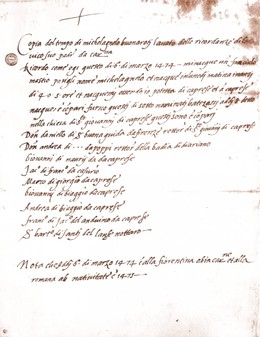 At the time of Michelangelo's birth, however, the family was going through a period of economic penury: his father was so impoverished that he was even about to lose his privileges as a Florentine citizen. The Podesteria of Caprese, one of the least significant Florentine possessions, was a political position of little importance, which he accepted to try to ensure a decent survival for his family, rounding off the meagre income from some farms around Florence. The decline heavily influenced the family's choices, as well as the young Michelangelo's destiny and personality: the concern for his and his family's economic well-
At the time of Michelangelo's birth, however, the family was going through a period of economic penury: his father was so impoverished that he was even about to lose his privileges as a Florentine citizen. The Podesteria of Caprese, one of the least significant Florentine possessions, was a political position of little importance, which he accepted to try to ensure a decent survival for his family, rounding off the meagre income from some farms around Florence. The decline heavily influenced the family's choices, as well as the young Michelangelo's destiny and personality: the concern for his and his family's economic well-
On 18 February 1564, almost eighty-
The inventory drawn up a few days after his death (19 February) records a few items, including the Pietà, two small sculptures whose fate is unknown (a St. Peter and a small Christ carrying the cross), ten cartoons, while the drawings and sketches seem to have been burnt shortly before his death by the master himself. A large "treasure" worthy of a prince was found in a chest, which no one would have imagined in such a poor home.
(Taken from Wikipedia)

8 MARCH
International Women's Day
On 8 March we celebrate, or rather, WOMEN celebrate their holiday, which is actually called "International Women's Day". This holiday, recognised throughout the civilised world, is to commemorate all the achievements of women in the economic, political and social spheres, but also and above all for the discrimination and violence to which women, unfortunately, continue to be subjected. Obviously, the 'feast' understood as the commemoration of the Day has a very different meaning from the one that modern consumerism has wanted to imprint on it. It is only right, not to say MUST, that we remember its origin.
We all know, more or less, the legend, because this is what it is about, that at the beginning of March 1908 the women workers of a textile factory in New York began to strike against their inhuman working conditions. The owner of the factory barricaded all the exits to prevent the workers from leaving their workplaces as a result of the strike. Shortly afterwards, for unknown reasons, perhaps started by the owner himself, a fire broke out in which 126 workers lost their lives. And so far the legend is well known. But not everyone, I think, knows that there was in fact no fire in New York on 8 March 1908 in which 126 workers lost their lives, but there really was on 25 March 1911 at the Triangle Shirtwaist Company, located in the heart of Manhattan, at the intersection of Greene Street and Washington Place, just east of Washington Square Park, which was, at the time, one of the largest garment factories. There are shocking images of the fire that broke out, reflecting the various accounts of what happened.
The factory employed around 600 workers (500 women and 100 men). On 25 March, a fire broke out on the eighth floor and quickly spread to the two upper floors, killing 146 men and women workers. Most of the victims, needless to say, were women, mostly young people between the ages of 13 (yes, you read that right! 13) and 22. They were all immigrants of Italian and Jewish origin who had come to the United States with their families in search of a better life.
In barely half an hour, the flames burst into flames, suffocating or burning alive the 146 victims. Some rushed to the windows of the building, but soon realised that the stairs of the fire brigade, who had come to their aid, were too short to reach the higher floors where the fire was spreading. They had to choose between jumping into the void or burning to death....
Going back to the origins of Women's Day, the first, real Women's Day (which later became International) was celebrated in the United States on 19 March 1911, but not because of the fire, although devastating in terms of innocent victims, which occurred a few days later, but to commemorate the fact that, on 19 March 1848, the King of Prussia had to recognise women's right to vote! A right acquired by the (armed) force of the people's union for the recognition of this right to all women in Prussia.
And the mimosa? The custom of giving mimosas as gifts is uniquely Italian. In the rest of the world there is no such custom. But where does it come from? To find out, we have to go back almost 70 years and arrive in 1946, when two women, Rita Montagnana (Palmiro Togliatti's wife) and Teresa Mattei, proposed adopting this flower as the symbol of Women's Day.

15 MARCH
The Ides of March and Julius Caesar
Hands up who has not studied the Ides of March at school. 2063 years ago, Gaius Julius Caesar was assassinated.
The 'ides' take their name from the Romans, who gave the fifteenth day of the months of March, May, July and October.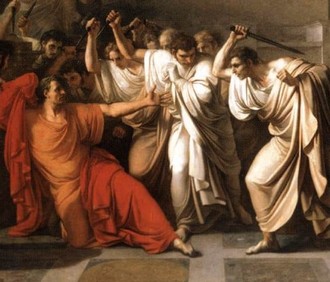 And on 15 March a group of republican conspirators, including his son Marcus Junius Brutus, murdered the Dictator Julius Caesar with 23 stab wounds.
And on 15 March a group of republican conspirators, including his son Marcus Junius Brutus, murdered the Dictator Julius Caesar with 23 stab wounds.
The warnings of Calpurnia, his wife, who had dreamt the night before of her husband's murder, were of no avail.
But like all leaders, Caesar did not listen to the concerns of "a woman", not least because he MUST give an important speech in the Senate, and his absence would have been destructive to his figure.
Caesar went to meet his destiny perhaps aware of what awaited him, Calpurnia's words had left a small, insignificant, but present hint, nevertheless, he held his harangue before the Senate, and shortly after the end of his speech, everything already planned, he was assassinated by the conspirators.
In the last groan of breath that Caesar had, he managed to pronounce the famous phrase, addressed to his son, which has remained in history as his murder:
<< Tu, quoque, Brute, fili mi..>> ( You too, Brutus, my son.. ).
One of the greatest emperors in the history of the Roman Empire died on 15 March 44 BC.

18 MARCH
"National Day of Covid Victims"
On 18 March each year, the National Day in memory of the victims of the coronavirus epidemic will be celebrated.
The Day was formally established on 17 March with the unanimous approval of the relevant law by the Senate Constitutional Affairs Committee, meeting in deliberative session.
On this national day, all public and private places will observe a minute's silence dedicated to the victims of the epidemic and public buildings will display flags at half-

MAY 27, 1993
"Georgofili massacre"
On the night of May 26-
The bombing was the work of Cosa Nostra against the application of Article 41bis, which provided for hard prison for mobsters.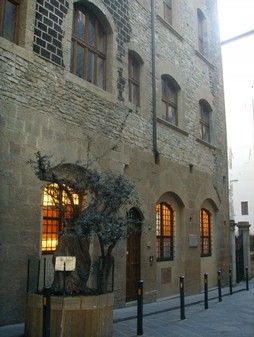
Five people died in the bombing:
Mr. and Mrs. Fabrizio and Angela Nencioni, with their daughters Nadia, 9 years old, and Caterina, just 50 days old, and a student who also lived in the tower, Dario Capolicchio, 22 years old.
I remember that night very well.... At that time my wife and I were still engaged, we would be married less than a year later, and that evening we were just walking through the neighboring streets just as the bombers parked the Fiorino.
Late in the evening, as was the custom at that time, we went up to the Piazzale Michelangelo, to take the usual tour of the square, to see the panorama of our Florence, although by now we know it in detail in our minds, and to get an ice cream at one of the two ice cream parlors at the entrance to the square.
We were running late, even though work was waiting for us the next day we were young, and the few hours of sleep that awaited us were certainly not scary at that age.
We returned home on time, shortly after 12:30.
We had not yet fallen asleep when we distinctly heard the roar of the explosion.
We lived in the suburbs, but as the crow flies we were talking about a few kilometers, nothing more....
We thought of everything except an assassination attempt. We found out in the morning, when all the TV stations, national and local, were talking about nothing else.
I remember very well that it left us all stunned. I was already a Misericordia volunteer, and I remember that our then deputy governor was there, on Via dei georgofili, coordinating the intervening volunteers. Not everyone could intervene; there was a lot of concern about what happened.
Almost 30 years have passed, but I still have the vivid memory of those events.
5 victims! 5 innocent souls. Let's not forget them...

7 AUGUST 2020
As good Florentines as we consider ourselves, we cannot help but remember that on 7th August 600 years ago, the construction of the undisputed symbol of Florence began:
The Dome of the Cathedral of S. Maria del Fiore, or more commonly known as CUPOLA DEL DUOMO.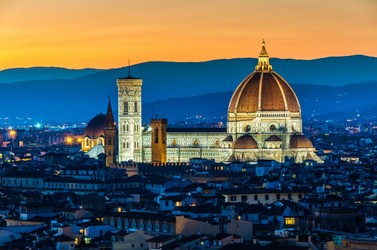 The work began on 7th August 1420 under the direction of Filippo Brunelleschi, or it would be more correct to say "Filippo di Ser Brunellesco Lapi", born in Florence in 1377 and died in 1466.
The work began on 7th August 1420 under the direction of Filippo Brunelleschi, or it would be more correct to say "Filippo di Ser Brunellesco Lapi", born in Florence in 1377 and died in 1466.
The dome was completed in 1436, and in 1466 those for the construction of the lantern, that is the part of the top of the dome, began, but they were followed and completed by another architect of the time, Michelozzo Michelozzi, as Brunelleschi died a few months after winning the public competition for the construction of the lantern.
The dome, together with the adjoining bell tower but of previous construction, is the undisputed architectural symbol of Florence.
Therefore... LIVE FLOWER!

9 AUGUST
We cannot but talk about another famous monument, even if it is Pisan ^_^ (it is well known of the parochialism that exists, oramami since centuries immemorial and only on school books, between Florentines and Pisans...).
Let's talk about the Hanging Tower!
Well, it is fair to say that the tower is actually the bell tower of the adjacent Cathedral ( or Duomo ) in the equally famous Piazza del Duomo, or better known as Piazza dei Miracoli.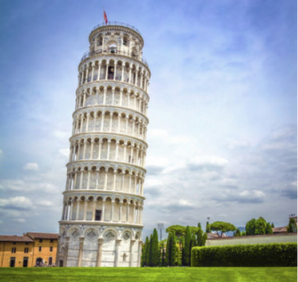 Its construction, with the laying of the first stone, began on August 9, 1173, by the architect Bonanno Pisano, although there is some discussion about who was really the author of this work.
Its construction, with the laying of the first stone, began on August 9, 1173, by the architect Bonanno Pisano, although there is some discussion about who was really the author of this work.
The construction work was abruptly interrupted due to the subsidence of the land, stopping on the third floor of the building. They restarted in 1275, with the construction of the other three floors, but inclined in the opposite direction to the slope, in an attempt (space) to straighten the tower...
It is also said that Galilei did his experiment on the weights right from the top of the leaning tower, but we are not sure of this today.
A last curiosity that few people know, except for his Pisan friends, of course... There are two other leaning towers in Pisa:
The bell tower of the church of S. Nicola and the bell tower of San Michele degli Scalzi!
Both, as for the tower of the cathedral, were built on a sandy and gravelly ground, and this has led to their inclination ranging from 2.5 degrees to 5.

30th November Feast of Tuscany
Peter Leopold of Lorraine succeeded to the Grand Ducal throne of Tuscany in 1765, following the death of his brother Francesco. Pietro Leopoldo, unlike his brother Francesco, was an enlightened and innovative sovereign. He promoted the reclamation of the marshy areas of the Maremma and the Val di Chiana, and also favoured the development of the Accademia dei Georgofili, the historic Florentine institution that promoted (and still promotes today) studies in agronomy, silviculture, economics and agricultural geography.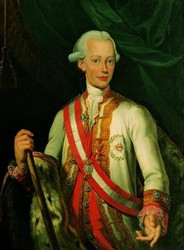 On 30th November 1786, with a reform that would "renew" the whole of Tuscany, Peter Leopold abolished the death penalty in the Grand Duchy, the first state in the world to do so, for the reasons that we are going to report below in the transcription of article 51 ( LI ) of the "Reform Law of the Tuscan Criminal Law", better known as the "Leopoldine Code":
On 30th November 1786, with a reform that would "renew" the whole of Tuscany, Peter Leopold abolished the death penalty in the Grand Duchy, the first state in the world to do so, for the reasons that we are going to report below in the transcription of article 51 ( LI ) of the "Reform Law of the Tuscan Criminal Law", better known as the "Leopoldine Code":
"Peter Leopold, by the grace of God, Royal Prince of Hungary and Bohemia, Archduke of Austria, Grand Duke of Tuscany.
[...]
With the greatest satisfaction of our paternal heart we have finally recognized that the mitigation of sentences combined with the most exact vigilance to prevent reactions, and through the rapid dispatch of trials, and the readiness and security of the punishment of the real criminals, instead of increasing the number of crimes has considerably reduced the most common, and made the atrocities almost unheard of, and therefore we have come to the determination not to delay any longer the reform of Criminal Law, with which the death penalty is abolished for the most constant maximum, as not necessary for the purpose proposed by the Company in the punishment of the Rei, the use of Torture, the Confiscation of the Criminals' property, as tending for the most part to the damage of their innocent families who have no complicity in the crime, has been eliminated at all, and disregarded by the Legislation the multiplication of the crimes improperly said of the injured Majesty with refinement of cruelty invented in perverse times, and fixing the penalties proportionate to the crimes, but inevitable in the cases in question, we are determined to order with the fullness of Our Supreme Authority what follows.
[...]
LI. We have seen with horror how easily in the past Legislation the Death Penalty was decreed for Crimes not yet serious, and having considered that the object of the Penalty must be the satisfaction of the private and public damage, the correction of the Reo son also of the Society and the State, of which it can never despair, the security in the Rei of the most serious and atrocious crimes that do not remain free to commit others, and finally the Public example that the Government in punishing crimes, and in serving the objects, to which it is only directed, is always obliged to use the most effective means with the least possible harm to the Rei; that this effectiveness and moderation together is achieved more than with the Death Penalty, with the Penalty of Public Works, which serve as a continuous example, and not a momentary terror, which often degenerates into compassion, and takes away the possibility of committing new crimes, and not the possible hope of seeing a useful and correct Citizen return to the Society; having also considered that a very different Legislation could better suit the gentler and more docile customs of the present century, and especially in the people of Tuscany, we have come in the determination to abolish as we have abolished with this Law forever the Death Penalty against any Reo, whether present or in absentia, and even though I confess, and convinced of any Crime declared Capital by the Laws promulgated so far, all of which we want in this part ceased and abolished.
[...]
Such is Our will, to which We command that it be given full execution throughout our Grand Duchy, notwithstanding any Law, Statute, Order, or Consuetude to the contrary.
Given in Pisa on 30th November 1786.
Peter Leopold
 (signed by Peter Leopold of Lorraine)
(signed by Peter Leopold of Lorraine)
On 21st June 2001, the Council of the Region of Tuscany, approved a law ( n. 26) by which it established, on 30th November, the feast of the Region of Tuscany, a feast that wants to pay homage to all those who recognize themselves in the values of peace, justice and freedom.
Translated with www.DeepL.com/Translator (free version)
